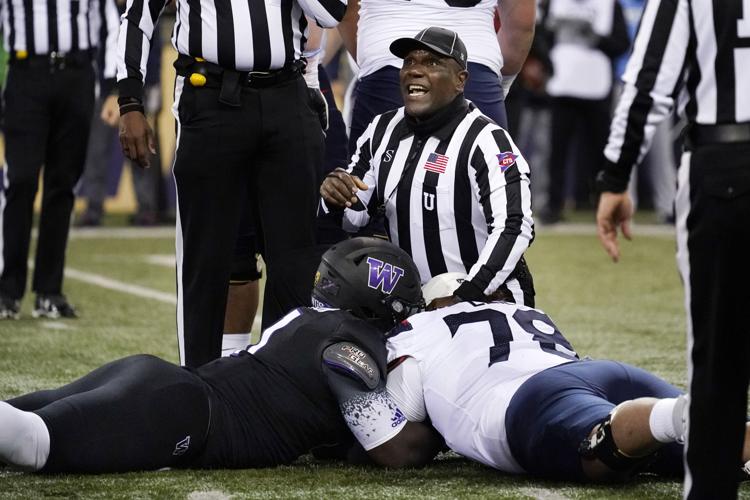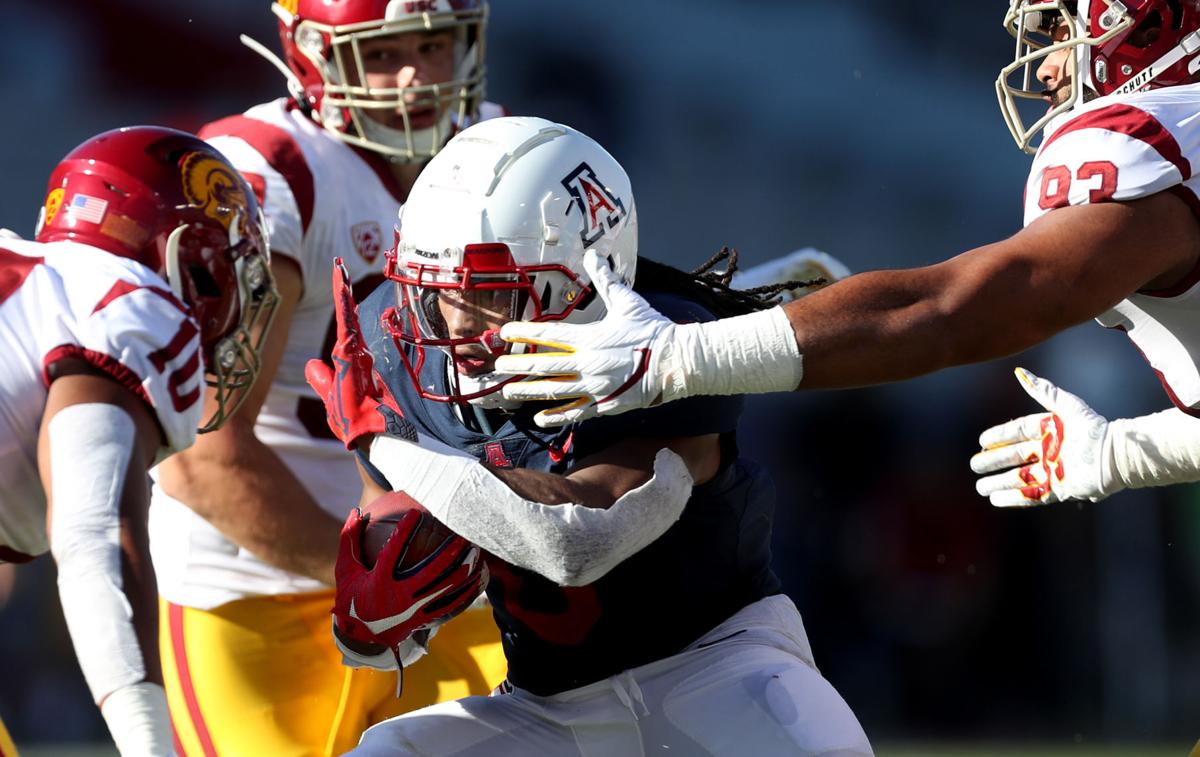It’s been a while.
When Arizona visits UCLA on Saturday — assuming the game takes place as scheduled — it will have been 420 days since the Wildcats won a football game.
A lot has happened since Oct. 5, 2019, when the UA defeated Colorado 35-30 in Boulder. The 2020 season didn’t start on time, and Arizona’s nonconference opponents were dropped. The Wildcats might have defeated Hawaii in the originally scheduled opener on Aug. 29. They most certainly would have beaten Portland State the following week.
Either way, Arizona wouldn’t have gone 420 days (and counting?) without a win. It wouldn’t be taking a program-record nine-game losing streak to the Rose Bowl.
But as Kevin Sumlin said after last Saturday’s loss at Washington: “That’s where we are.”
Although all defeats aren’t created equal, common threads can be found within the skid. In this week’s “Cats Stats,” we examine nine of them — one for each setback.

Editor’s note: Each week throughout the football season, we’ll take an in-depth look at the Arizona Wildcats from a statistical perspective.
1. Points allowed
Let’s start with the basics. Over the course of the streak, Arizona has allowed 360 points — 40 per game. The Wildcats have yielded 50-plus twice and 40 or more three other times.
The only two times Arizona has held an opponent under 34 points since last year’s UCLA game (a 20-17 victory) were the Colorado game and the Territorial Cup. Arizona State scored only 24 points that night. The UA managed just 14.
Entering this week, only five teams were allowing 40 or more points per game this season: Northern Illinois, Ole Miss, Bowling Green, Kansas and Akron. All were winless except the Rebels (3-4).
2. Yards allowed
Yes, defensive struggles will be a theme here. Over the course of the streak, Arizona has allowed 470.9 yards per game. Only twice have opponents failed to gain at least 450 yards — USC last season (448) and ASU (338).
Even in this year’s opener, when it felt as if the UA defense played decently, the Wildcats surrendered 498 yards.
That 450 figure isn’t a definitive marker that determines whether Arizona wins or loses. The UA surrendered 496 yards in the win at Colorado. But anytime you’re in that territory, it’s suboptimal.
Looking again at this season’s stats, 30 teams were allowing 450-plus yards per game entering this week. Only four had winning records: UCF, Wake Forest, Maryland and Memphis.
3. Net yards per play
The cool kids prefer yards per play to total yards. It’s a telling stat for Arizona, especially when you look at the difference between the Wildcats’ yards per play and their opponents’.
Over the course of the streak, Arizona has averaged fewer yards per play than its opponent seven times. The only exceptions: last year vs. Stanford (by a fraction — 6.43-6.38) and ASU (5.5-4.6).
The game against the Sun Devils keeps popping up as an outlier. The key stat in that one: a minus-3 turnover ratio. (We’ll have more on turnovers shortly.)
Not only have the Wildcats been on the wrong end of yards per play seven times, the difference has been 1.5 yards or more six times. The only time it wasn’t: this year’s opener vs. USC (6.6-5.8). It’s no coincidence that’s the only game Arizona has lost by fewer than 10 points (34-30 final).

Umpire Gregory Adams looks up to make a call on a fumble recovery as Washington’s Josiah Bronson, left, and Donovan Laie continue to fight for possession during the first half of an NCAA college football game Saturday, Nov. 21, 2020, in Seattle. Washington won the call. (AP Photo/Elaine Thompson)
4. Takeaways
Arizona has struggled to take the ball away from its opponents since last September. The UA had two takeaways vs. Texas Tech on Sept. 14, the third straight game in which the Wildcats had two or more. At that point, through three games, they had 10.
In the 11 games since, including wins over UCLA and Colorado, Arizona has just five takeaways. The Wildcats haven’t had more than one in any game over that stretch. They’ve had none six times, including both games this season.
It isn’t as if the UA offense has given the ball away an inordinate number of times either. Arizona had multiple turnovers last year against Washington (four), USC (three), Stanford (two) and ASU (three). In the other five losses, the Wildcats committed only one total turnover — Grant Gunnell’s interception vs. USC in this year’s opener.
5. Sack differential
Many studies have shown that turnovers are at least partially a product of luck — that they even out over time. So why hasn’t the Arizona defense regressed to the mean in that regard?
Well, if there’s one surefire way to cause turnovers, it’s pressuring the quarterback. And that’s another area where the Wildcats have been deficient — especially compared to their opponents.
Arizona has 14 sacks during the losing streak, which isn’t terrible. Most of them — 10 — came during the four games that Chuck Cecil served as interim defensive coordinator at the end of last season.
Meanwhile, the Wildcats’ foes have 35 sacks over the past nine games. Those sacks have accounted for 231 lost yards. Arizona’s 14 sacks have accounted for 87 lost yards. That’s a difference of 16 yards per game.
6. Net punting
This is another stat that contributes to “hidden” yardage.
Arizona has had a higher net punting average than its opponent only three times during the streak. Four times the opposition’s average was at least 8.5 yards greater than the Wildcats’.
One of the times Arizona had a higher figure was nothing to brag about. The Wildcats had a net average of 33.3 yards vs. Utah last season. The Utes punted only once, for 31 yards.
Thanks to freshman Tyler Loop, Arizona has improved in this area this season. USC and Washington had higher averages but by only 1 and 3.4 yards, respectively. Loop has a respectable net average of 39.0 yards.
7. Field position
Lack of takeaways, negative sack differential, erratic punting — they all contribute to poor field position.
Incredibly — or perhaps predictably — Arizona has had worse average starting field position than its opponents in every game during the streak.
On six occasions, the difference has been 13 yards or greater, including both games this year. Only once since the start of the 2019 season has the UA had an edge in average starting position (UCLA, plus-9).
8. Third-down differential
This was one of the biggest factors in the loss to Washington last week. Arizona went 2 of 13 on third down. UW went 8 of 15. It wasn’t an isolated incident.
Over the course of the streak, the Wildcats have had a lower third-down conversion percentage than their opponents six times. They have been over 50% only once — 60% against Oregon State. But that was offset by the Beavers converting 70%.
In all, UA opponents have converted 47.1% of their third downs during the streak. Arizona has converted 35.8%.
In the first five games last season — when the Cats went 4-1 — Arizona had 41 conversions in 77 attempts (53.3). The Wildcats had the same number of conversions over the final seven games but needed 109 attempts (37.6%).
9. Time of possession
Some coaches don’t believe time of possession matters. Alabama coach Nick Saban was asked last week about losing the possession battle against Kentucky in the first half — in a game the Crimson Tide won 63-3.
“That last time I checked,” Saban said, “you get nothing for time of possession.”
But Arizona isn’t Alabama. When it comes to the Wildcats — who haven’t had adequate depth on defense for years — time of possession holds meaning.
Arizona has lost the possession battle six times during the skid. On five occasions, the margin has been at least 8 minutes, 48 seconds. The three times the Wildcats have won time of possession, the difference has been less than a minute.







